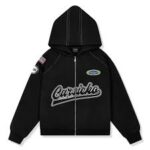The Rise of a Different Kind of Streetwear
In a world saturated with streetwear brands fighting for attention through bold graphics, limited drops, and celebrity endorsements, Mad Happy stands out—not by being louder, but by being more meaningful. Founded in 2017 by four friends—Peiman Raf, Noah Raf, Mason Spector, and Joshua Sitt—Mad Happy quickly gained traction not only for its aesthetic appeal but for its mission: to create conversation around mental health through clothing. What makes Mad Happy unique isn’t just the colorful palettes or the playful typography—it’s the raw vulnerability it brings into an industry often focused on hype and exclusivity. With Mad Happy, fashion becomes a vehicle for change, a tool to connect people, and a platform that brings emotional well-being to the forefront.
Founders with a Purpose: A Story Rooted in Emotion
The origins of Mad Happy are deeply personal. Unlike many streetwear brands that are born from a love of skate culture or graffiti, Mad Happy was born from a need for openness. The founders, particularly Mason Spector and Peiman Raf, have spoken candidly about their own experiences with mental health challenges. This honesty forms the cornerstone of the brand’s identity.
Rather than building a brand around a trend, they built it around a truth. They knew that if they were dealing with anxiety, depression, and the pressures of modern life, others were too. That vulnerability resonated. From day one, Mad Happy didn’t pretend to have all the answers. Instead, it fostered a sense of community—inviting customers to participate in the journey toward well-being rather than simply wear a logo.
Aesthetic with Intent: More Than Just Streetwear
Mad Happy’s visual identity is both nostalgic and forward-thinking. Vibrant, pastel-heavy colorways give the garments a feel-good look, almost reminiscent of childlike joy—an intentional contrast to the often-heavy themes of mental health that the brand addresses. This juxtaposition creates a visual metaphor: even in darkness, there’s room for light.
Their hoodies, sweatpants, and graphic tees come adorned with simple, yet impactful messages: “Local Optimist,” “Be Present,” and “Mental Health Awareness.” These are not just slogans; they are affirmations. Each piece serves as a wearable reminder to stay grounded, to connect, and to care.
The design language, while modern and minimalistic, doesn’t sacrifice comfort. Crafted with high-quality materials and tailored cuts, Mad Happy’s clothing is both fashionable and functional. Their limited-edition drops and collaborations keep the collections fresh and highly sought after, yet the brand never strays far from its core mission.
Mental Health as a Movement: A Brand with a Message
At the heart of Mad Happy is its unwavering dedication to mental health advocacy. The brand doesn’t treat mental health as a buzzword—it treats it as a lifelong commitment. This is most evident in the creation of The Mad Happy Foundation, a non-profit arm launched in 2021. The foundation works to raise awareness, increase access to mental health resources, and fund research—all in the service of creating a healthier, more supportive society.
Through both their foundation and brand messaging, Mad Happy normalizes emotional conversations. They leverage their influence not just to sell hoodies, but to start dialogues. On social media, in pop-ups, and through blog-style content on their website, Mad Happy shares stories, tips, and perspectives related to well-being. They speak with empathy, not authority. It’s not about telling people how to feel—it’s about letting people know it’s okay to feel.
This focus on vulnerability and connection has made Mad Happy resonate particularly strongly with younger generations. In a cultural moment when Gen Z and millennials are prioritizing mental health more than ever, Mad Happy doesn’t feel like a brand—it feels like a friend.
Collaborations that Matter: Merging Creativity with Purpose
Madhappy Tracksuit has had no shortage of high-profile collaborations, yet what sets them apart is how each partnership enhances—not dilutes—their core mission. Collaborations with brands like Columbia Sportswear, LVMH-backed companies, and even global platforms like the NBA have allowed Mad Happy to reach diverse audiences while staying true to their purpose.
Take, for example, their partnership with Columbia. The collection featured technically sound outerwear with thoughtful messaging, blending functionality with emotional awareness. These collaborations are carefully curated to elevate both the aesthetic and the advocacy.
Their pop-ups in cities like New York, Los Angeles, and Miami are not just retail experiences—they’re community hubs. Often, these spaces feature wellness panels, journaling stations, and mental health professionals on-site. It’s not just about buying a hoodie—it’s about being part of something larger.
The Local Optimist Club: A Community Without Borders
One of the brand’s most compelling initiatives is the Local Optimist Club. More than just a catchy phrase on a T-shirt, it’s a digital and physical community designed to foster connection among individuals who prioritize mental health and optimism. Through this initiative, Mad Happy hosts online events, wellness workshops, and candid conversations about mental health.
The Local Optimist platform also includes a blog and newsletter, covering topics from seasonal affective disorder to burnout and mindfulness practices. These resources are both accessible and educational, offering practical advice and personal stories. By building this ecosystem, Mad Happy extends its impact beyond commerce into education, wellness, and community care.
Sustainability and Ethical Responsibility: The Next Layer of Care
While mental health remains at the forefront, Mad Happy is also stepping into the sustainability space. As a brand that promotes holistic well-being, it only makes sense that this care extends to the planet. Their newer collections have started to incorporate organic cotton, low-impact dyes, and more responsible manufacturing practices.
They also promote conscious consumerism by releasing limited quantities of each drop. This not only maintains the brand’s exclusivity but reduces overproduction and waste. Mad Happy isn’t just about feeling good—it’s about doing good.
In a world where fast fashion dominates and ethical responsibility often falls by the wayside, Mad Happy’s efforts—though still evolving—signal a commitment to long-term positive change across multiple dimensions.
Celebrity Endorsements with Authentic Alignment
Like any streetwear label, Mad Happy has benefited from celebrity attention. Everyone from LeBron James to Gigi Hadid has been spotted wearing their gear. But what’s notable is how little the brand relies on these moments for validation. Rather than chase clout, Mad Happy allows celebrities to come to them—and most do because they resonate with the brand’s message.
In fact, many influencers and public figures have spoken out about their personal struggles with mental health, and Mad Happy provides them with a platform that feels safe and authentic. In a time when authenticity is currency, Mad Happy’s refusal to compromise earns them not only followers, but loyalty.
Criticism and Challenges: Walking the Line Between Commerce and Compassion
No brand is without its critics, and Mad Happy has faced its fair share. Some skeptics argue that commodifying mental health—putting “Be Happy” slogans on $200 hoodies—is inherently exploitative. These concerns are not without merit, and Mad Happy seems to understand the delicate balance it must maintain.
To its credit, the brand consistently reinvests in its mental health initiatives and remains transparent about its goals and limitations. While critics serve as a reminder that the intersection of capitalism and social good is complex, Mad Happy continues to approach this space with intentionality, humility, and a willingness to grow.
The Future of Mad Happy: More Than Just a Brand
As the fashion world continues to evolve, Madhappy Hoodie stands poised to shape its future—not just through garments, but through a paradigm shift in what brands can and should stand for. They’ve proven that it’s possible to sell hoodies and healing in the same breath, to build a business that puts people over profit, and to create clothing that carries more than thread—it carries meaning.
Their next frontier appears to be global. As their influence expands internationally, so too does their opportunity to impact communities far beyond their Los Angeles roots. More pop-ups, wellness partnerships, content platforms, and global mental health campaigns are likely on the horizon.
What started as a small apparel company with a lofty mission is now a global movement, reshaping the landscape of fashion and emotional intelligence alike. Mad Happy is no longer just a brand. It’s a cultural touchstone.
The Power of Optimism in a Complicated World
In an era defined by rapid change, social anxiety, and emotional overload, Mad Happy offers something rare: hope. Not the saccharine kind of hope that ignores pain, but a nuanced, grounded optimism—one that acknowledges life’s challenges while choosing to believe in the possibility of something better.
Through design, storytelling, and community-building, Mad Happy has managed to do what few brands can—make people feel seen. And in doing so, they’ve become more than relevant. They’ve become necessary.
As we navigate an uncertain future, it’s comforting to know that some brands aren’t just selling us things. They’re walking beside us, reminding us that it’s okay to not be okay—and that even in our lowest moments, we’re not alone. That is the legacy Mad Happy is building. And it’s only just beginning.


